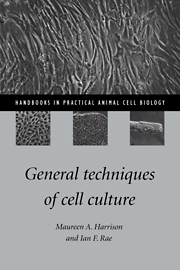8 - Quality control
Published online by Cambridge University Press: 02 February 2010
Summary
Guidelines have been given in Chapters 1, 3 and 5 concerning the handling of new cell lines in such a way that the researcher can be assured that the cells are free of contamination, but quality control is not a procedure kept solely for use when new material is received or when primary cultures are set up in the laboratory. The continuous monitoring of cultures and ingredients is essential and requires constant vigilance. Some contaminants are visible to the naked eye but others, e.g. contamination with some strains of mycoplasma are not, and even the effects of such infection may not be immediately obvious, hence the need for constant testing. The importance of carrying out experiments with contaminant-free cells cannot be overstressed (Mowles & Doyle, 1990).
Once contamination is present in a culture, it can easily be spread, so it is necessary that all staff are aware of the potential for problems to occur. However, in some cases the presence of a contaminant may not be such a calamity as it was before the days of mycoplasma removal agents and a wide range of efficient antibiotics.
Many laboratories indulge in the practice of using antibiotics in cell culture as a routine procedure. This leads to the suppression of bacterial contamination which can encourage the spread of antibiotic-resistant strains. Antibiotics can also reduce levels of mycoplasma, making them harder to detect. Microbial quality control is concerned with the testing of cell lines and media for a variety of micro-organisms including bacteria, yeasts, fungi, viruses and mycoplasma.
- Type
- Chapter
- Information
- General Techniques of Cell Culture , pp. 103 - 121Publisher: Cambridge University PressPrint publication year: 1997

